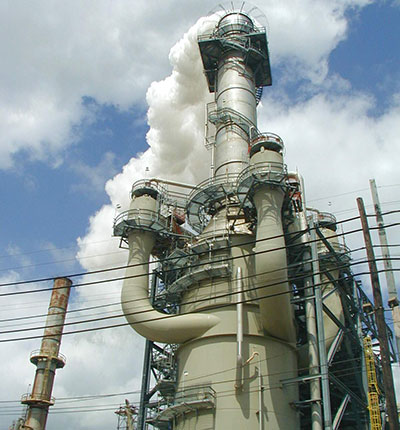Wet Gas FCC Scrubbers
Effective and proven fluid catalytic cracking (FCC) emissions control
With our acquisition of certain assets of Hamon Research-Cottrell in 2022, B&W is now a licensee of the ExxonMobil wet gas scrubbing (WGS) technology which allows refiners to reliably meet stringent fluid catalytic cracking (FCC) emissions regulations with well-proven technology.
Developed by ExxonMobil in the 1970s and now licensed by B&W, the WGS technology removes particulates and sulfur dioxide (SO2) by intimate mixing of the flue gases with an aqueous scrubbing liquid. The technology can also be enhanced to meet tighter restrictions on nitrogen oxides (NOx) or particulate.
Refiners can take advantage of B&W’s more than 155 years of experience and global leadership position in providing energy and air pollution control equipment to a wide range of industries.

Easily retrofits into existing plants
WGS technology can be retrofitted into full-burn or partial-burn FCC units, even those with first-generation carbon monoxide (CO) boilers and very low flue gas pressure.

The typical WGS project scope includes the scrubber vessel from the flue gas inlet to the stack, the recirculation pumps and piping, scrubber instrumentation and control, caustic and water make-up systems, scrubber purge, and the purge treatment unit to produce solids for disposal and non-hazardous liquid.
Wet gas scrubbing technology advantages:
- Avoids costly CO boiler upgrades with inlet scrubber pressures as low as zero inches of water
- Maximizes cat cracker availability – scrubber run lengths match longest FCC up-time in the industry
- Meets or exceeds stringent particulate and sulfur oxides (SOx) emission regulations
- Produces non-hazardous liquid
- Collects catalyst suitable for direct low-cost disposal

Wet Gas FCC Scrubber Installation

High reliability
Since introducing the technology in the 1970s, more than 50 FCC units have been fitted with wet gas scrubber systems worldwide. The robustness of the fundamental design is evidenced by many of the earliest units which continue to perform today. Subsequent improvements in design, performance and capital cost have continued to advance the technology while maintaining the integrity and reliability of the system. With run lengths more than four years and matching the longest FCC up-time in the industry, Wet gas scrubber units have typically operated until the FCC is ready for its turnaround.
Two available wet gas FCC scrubber designs provide flexibility for any application
High Energy Venturi (HEV)
- Preferred choice full-burn units when flue gas pressure is high
- Uses gas pressure to push gas through venturi
- Gas kinetic energy breaks liquid into small droplets
Jet Ejector Venturi (JEV)
- Preferred choice for partial-burn units when flue gas pressure is low
- Liquid flow in the venturi creates suction pressure
- Has lower back pressure than any other available scrubber
- Liquid kinetic energy breaks liquid into drops
- Ideal for retrofits with older CO boilers that cannot take high back pressure


Unique applications for combined particulate and acid gas removal
For effective flue gas pre-treatment in post-combustion carbon dioxide (CO2) capture applications or for very high emission removals, wet electrostatic precipitator (ESP) technology can be integrated on top of the wet gas FCC scrubber. This arrangement provides for both acid gas reduction and particulate removal, including aerosols, all within a compact footprint.
Serving the Petrochemical and Refining Industry
Read more about how B&W has served the petrochemical & refining industry for many years by providing a wide range of clean power production technologies and aftermarket support services including parts, equipment upgrades and field engineering.